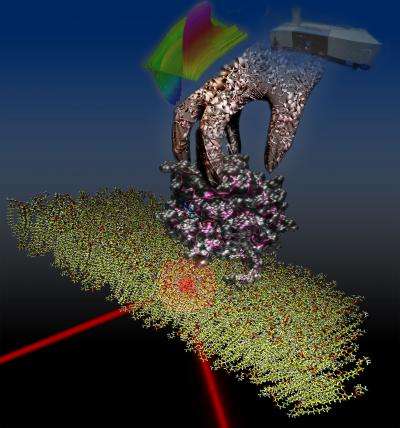Proteins hoist the anchor

Researchers from the Ruhr-Universität Bochum (RUB) and from the MPI Dortmund have for the first time successfully reproduced the recycling process of proteins regulating cellular transport in a biophysical experiment. In doing so, they traced in detail the way the central switch protein Rab is being extracted from the lipid membrane.
The team of PD Dr Carsten Kötting, Prof Dr Klaus Gerwert (Department of Biophysics, RUB) and Prof Dr Roger S. Goody (Max Planck Institute for Molecular Physiology, Dortmund) has published the spectroscopic and dynamic data in the PNAS journal's Online Early Edition. "Until now, this protein's interactions have only ever been studied in a solution – i.e. without a lipid membrane. The step into the protein's natural environment opens up entirely new possibilities," says Carsten Kötting. This is because many disease-relevant protein interactions within a cell take place on a membrane.
From solution to membrane
Unlike Ras proteins that regulate cell growth, Rab GTPases control the traffic between different cell sections. Just like Ras proteins, Rab GTPases (also called Rab proteins) act as switches. Turned "on", the high-energy GTP molecule is bound; turned "off", the lower-energy GDP molecule is bound. The switch protein Rab does not simply swim through the cell with the trafficked load it is carrying; rather, it is fixed within the membrane by means of lipid anchors. After the trafficking stage has been successfully completed, Rab is extracted from the membrane and recycled. This process has never yet been simulated in a biophysical experiment. The Bochum-Dortmund team has succeeded in manufacturing the Rab protein with the membrane anchor in its active form in large quantities, to bind it to an artificial lipid membrane and to investigate the process of extracting the switch protein from the membrane in a spectrometer.
Seize and pull hard
For this purpose, biophysicists used the method of ATR infrared spectroscopy, which enabled them to visualise processes on surfaces such as lipid membranes. They paid particular attention to the GDI protein that binds the Rab protein and its lipid anchor. The question was whether Rab dissociates spontaneously from the membrane and is seized by GDI or whether GDI plays an active part in the Rab recycling process. With ATR spectroscopy, the team was for the first time able to differentiate between these two processes and demonstrate the GDI protein's active role. "We observed that GDI approaches the membrane and seizes the Rab protein then and there," explains Konstantin Gavriljuk. "Thus, Rab is extracted from the membrane by GDI much more quickly than it would have otherwise dissociated."
Legionella affect cellular trafficking processes
Rab GTPases and their interaction partners have an impact on certain diseases, for example some forms of mental disabilities and legionnaire's disease. The agents causing legionnaire's disease, namely legionella, attack Rab proteins and modify them chemically, thus affecting cellular trafficking processes; they are thus able to reproduce in human cells. The experiments have shown that the chemical modification caused by legionella inhibits the process of Rab extraction from the membrane by GDI. "We have now gained a better understanding of where legionella attack cells and of the consequences thereof," says Carsten Kötting.
More information: PNAS, doi:10.1073/pnas.1307655110
Journal information: Proceedings of the National Academy of Sciences
Provided by Ruhr-Universitaet-Bochum

















